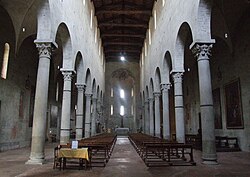San Bartolomeo in Pantano


San Bartolomeo in Pantano is a
History
The church and the adjacent
In 1433 the Benedictines, whose numbers had dwindled, were replaced by
Description
The church gained its present appearance at the time of Buono in 1159, rebuilt in the Pistoiese Romanesque style. Characteristic of this style is the façade, divided into five compartments with arches supported by slender columns, and with a marble bichrome decoration. The portal in the facade is graced with notable Romanesque sculptures; the architrave has a row of standing individuals in togas, depicting "Jesus with the Twelve Apostles" (dated to 1167). Above are two male lions, one atop a guarding a recumbant man, the other atop a bird. Above the portal is a latin script.
The interior was much changed over the centuries, but a restoration held in 1951-1961 brought it to the original appearance. In the apse was found a Christ in Majesty between Saints and Angels from the late 13th century, attributed to
See also
References
- ^ Pistoia e il suo territorio: Pescia e i suoi dintorni : guida del forestiero, by Giuseppe Tigri, Pistoia (1853): page 190.
- ^ Tigri, page 191.
